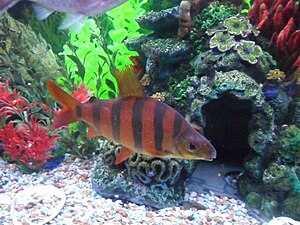Straight tetra
| Straight tetra | ||||||||||||
|---|---|---|---|---|---|---|---|---|---|---|---|---|

Zebra Geradsalmler ( Distichodus sexfasciatus ) |
||||||||||||
| Systematics | ||||||||||||
|
||||||||||||
| Scientific name | ||||||||||||
| Citharinoids | ||||||||||||
| Buckup , 1998 |
The Geradsalmler (Citharinoidei) are a subordination of the tetra-like (Characiformes). All representatives of the group live in fresh waters of tropical Africa south of the Sahara, as well as in the Nile. The suborder consists of two families, the real Geradsalmler (Citharinidae) with 3 genera and 8 species and the Distichodontidae with 17 genera and over 100 species.
features
Straight tetra can be very high back and strongly flattened on the sides, but they can also have a spindle-shaped, very elongated body. Many species are smaller than 20 cm, others can be half a meter or up to 80 cm long. The German name Geradsalmler refers to the straight sideline , a feature shared by all members of the subordination. Other common features of the Geradsalmler are the deeply forked caudal fin, the relatively many pelvic fin rays, the two-humped teeth, the autogenous neural arch of the fourth vertebra and the fused together second and third postcleithra (bones in the shoulder girdle). All straight tetra have an adipose fin and all, with the exception of the representatives of the genus Citharinus , have comb scales .
Geradsalmler are in most cases schooling fish, a few solitary ambulance hunters who live hidden in the vegetation.
Systematics
The straight tetra are one of two sub- orders of the characiformes. The second are the much more species-rich Characoidei that occur in Africa, South and Central America. At the beginning of 2017, it was questioned whether the tetra is actually a monophylum, i.e. a systematic unit that contains the last common ancestor and all of his descendants. According to a study published in February 2017, the suborder Characoidei is the sister group of the catfish-like (Siluriformes), i.e. more closely related to them than to the suborder Citharinoidei. The latter is the sister group of the clade formed by Characoidei and Siluriformes .
literature
- Joseph S. Nelson, Terry C. Grande, Mark VH Wilson: Fishes of the World. Wiley, Hoboken, New Jersey, 2016, ISBN 978-1118342336
Individual evidence
- ^ PA Buckup: Relationship of the Characidiinae and Phylogeny on Characiform Fishes (Teleostei: Ostariophysi). In: LR Malabarba, RE Reis, RP Vari, ZMS Lucena & CAS Lucena (Eds.): Phylogeny and Classification of Neotropical Fishes. Pp. 123-144, Porto Alegre, Edipucrs, 1998.
- Jump up ↑ Prosanta Chakrabarty, Brant C. Faircloth, Fernando Alda, William B. Ludt, Caleb D. McMahan, Thomas J. Near, Alex Dornburg, James S. Albert, Jairo Arroyave, Melanie LJ Stiassny, Laurie Sorenson, Michael E. Alfaro: Phylogenomic Systematics of Ostariophysan fishes: Ultraconserved Elements Support the Surprising Non-monophyly of Characiformes. Systematic Biology, syx038. February 2017, DOI: 10.1093 / sysbio / syx038